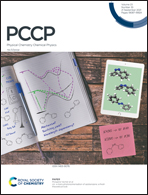Generalized energy-based fragmentation approach for calculations of solvation energies of large systems†
Abstract
A generalized energy-based fragmentation (GEBF) approach has been combined with a universal solvation model based on solute electron density (SMD) to compute the solvation energies of general large systems (such as protein molecules) in solutions. In the GEBF-SMD method, the solvation energy of a target system could be combined by the corresponding solvation energies of various subsystems, each of which is embedded in the background point charges and surface charges on the surface of solute cavity at the positions of its atoms and neighbouring atoms outside of the subsystem. Our results show that the GEBF-SMD model could reproduce the conventional SMD solvation energies quite well for various proteins in solutions, and could significantly reduce the computational costs for the SMD calculations of large proteins. In addition, the GEBF-SMD approach is almost independent of the basis sets and the types of solvents (including protic, polar, and nonpolar ones). Also, the GEBF-SMD approach could reproduce the relative energies of various conformers of large systems in solutions. Therefore, the GEBF-SMD method is expected to be applicable for computing the solvation energies of a broad range of large systems.

- This article is part of the themed collection: 2021 PCCP HOT Articles


 Please wait while we load your content...
Please wait while we load your content...